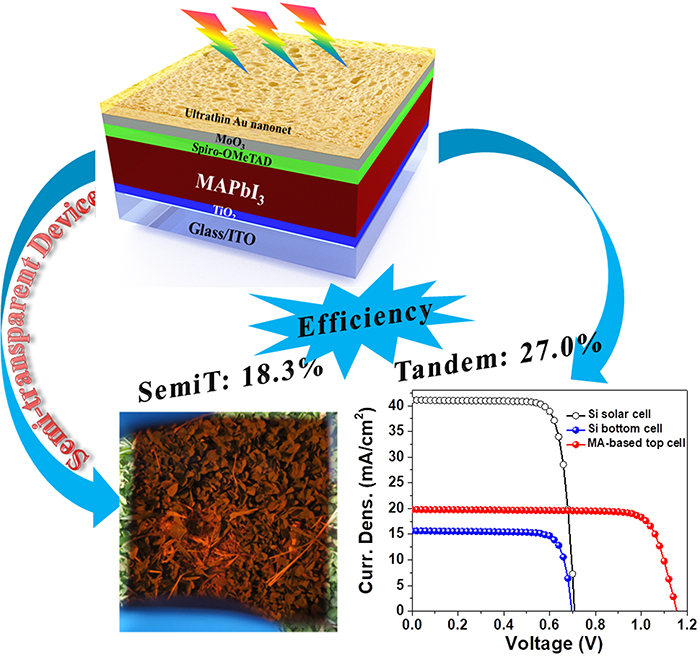A research group led by Prof. LIU Shengzhong from the Dalian Institute of Chemical Physics (DICP) of the Chinese Academy of Sciences (CAS), and Prof. YANG Dong at Shaanxi Normal University developed the high efficiency semi-transparent perovskite solar cells by using MoO3 sandwiched gold nanomesh (MoO3/Au/MoO3) multilayer as the transparent electrode. Combined with a superior heterojunction silicon solar cell, a high efficiency four-terminal perovskite/silicon tandem solar cell was obtained. Their findings were published in Advanced Functional Materials.

The top image is the device structure of the semi-transparent perovskite cell with ultra-thin gold nanonet as transparent electrode. The left image is the photograph of the semi-transparent device. The right image shows the J-V characteristic of the semitransparent perovskite top cell (red line) , the silicon bottom cell (blue line) and the silicon cell works indepently (black line).(Image by DUAN Lianjie, WANG Ziyu)
The crystalline Si-based solar cells have been dominating the ever-expanding global photovoltaic (PV) market with about 95% market share. With its highest cell efficiency of 26.6% reaching its theoretical limit, there is little hope to further raise its performance by just device optimization within the single-junction cell architecture.
Tandem/multijunction structure was proven to be an effective way to break the Shockley-Queisser limit. To obtain a high efficiency tandem solar cell, a key of merit thing is to fabricate transparent electrode with high cinductivity as well as high transparency using a mild mrthod.
To obtain the high conductive and high transparent transparent electrode, the group demonstrated a MoO3/Au/MoO3 multilayer fabricated by thermal evaporation. The thermal evaporation is mild that could not damage the underneath layer.
The large surface tension of MoO3 effectively improves wettability for gold, resulting in Frank–van der Merwe growth to produce an ultrathin gold nanomesh layer, which guarantees not only excellent conductivity but also great optical transparency. The top MoO3 layer reduces the reflection at the gold layer to further increase light transmission.
As a result, the semitransparent perovskite cell shows an 18.3% efficiency, the highest reported for this type of devices. When the semitransparent perovskite device is mechanically stacked with a heterojunction silicon solar cell of 23.3% PCE, it yields a combined efficiency of 27.0%, higher than those of both the sub-cells. This breakthrough in elevating the efficiency of semitransparent and multijunction/tandem devices can help to break the Shockley–Queisser limit.
The research was supported by the National Natural Science Foundation of China, National Key Research and Development Program of China, Shaanxi Technical Innovation Guidance Project, the 111 Project. (Text/Image by DUAN Lianjie, WANG Ziyu)